Junkers Ju 87
Design & Structure
Prototypes
Ju 87 V1:W.Nr 4921. Flown on 17 September 1935 Ju 87 V2:
W.Nr 4922, registration D-IDQR. Flown on 25 February 1936. Flown again as registration D-UHUH on 4 June 1937 Ju 87 V3:
W.Nr 4923. Flown on 27 March 1936 Ju 87 V4:
W.Nr 4924. Flown on 20 June 1936 Ju 87 V5:
W.Nr 4925. Flown on 14 August 1936
Ju 87A "Anton"
The second prototype had a redesigned single vertical stabiliser and a 610 PS (449 kW, 602 hp) Junkers Jumo 210 A engine installed, and later the Jumo 210 Da. The first A series variant, the A-0, was of all-metal construction, with an enclosed cockpit. To ease the difficulty of mass production, the leading edge of the wing was straightened out and the ailerons' two aerofoil sections had smooth leading and trailing edges. The pilot could adjust the elevator and rudder trim tabs in flight, and the tail was connected to the landing flaps, which were positioned in two parts between the ailerons and fuselage. The A-0 also had a flatter engine cowling, which gave the pilot a much better field of vision. In order for the engine cowling to be flattened, the engine was set down nearly .25 m (10 in). The fuselage was also lowered along with the gunner's position, allowing the gunner a better field of fire.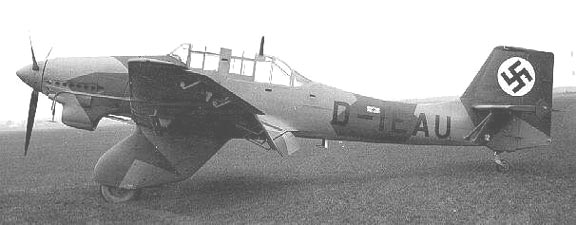
Junker Ju 87A.
[Source: Unknown]
Ju 87 A-0: Ten pre-production aircraft, powered by a 631 hp Jumo 210C engine. Ju 87 A-1: Initial production version. Ju 87 A-2: Production version fitted with an improved 671 hp Jumo 210E engine.
Ju 87B "Bertha"
The Ju 87 B series was to be the first mass-produced variant. A total of six pre-production Ju 87 B-0 were produced, built from Ju 87 A airframes. Test flights began from the summer of 1937. A small number, at least three, served as conversion Cs or Es for potential naval variants.
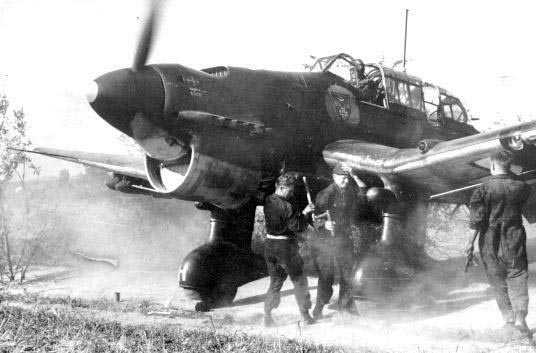
Junker Ju 87B.
[Source: Unknown]
Ju 87R
A long range version of the Ju 87 B was also built, known as the Ju 87 R. They were primarily intended for anti-shipping missions. The Ju 87R had a B-series airframe with an additional oil tank and fuel lines to the outer wing stations to permit the use of two 300 L (79,25 US gal) under-wing drop tanks. This increased fuel capacity to 1,080 litres (500 L in main fuel tank of which 480 L where usable + 600 L from drop tanks). To prevent overload conditions, bomb carrying ability was often restricted to a single 250 kg (550 lb) bomb if the aircraft was fully loaded with fuel. The Ju 87 R-1 had a B-1 airframe with the exception of a modification in the fuselage which enabled an additional oil tank. This was installed to feed the engine due to the increase in range after the addition of the extra fuel tanks. The Ju 87 R-2 had the same airframe as the B-2, and strengthened to ensure it could withstand dives of 600 kph (370 mph). The Jumo 211D in-line engine was installed, replacing the R-1s Jumo 211A. Due to an increase in overall weight by some 700 kg (1,540 lb), the Ju 87 R-2 was 30 kph (20 mph) slower than the Ju 87 B-1 and had a lower service ceiling. The Ju 87 R-2 had an increased range advantage of 360 km (220 mi). The R-3 and R-4 were the last R variants developed. Only a few were built. The R-3 was an experimental tug for gliders and had an expanded radio system so the crew could communicate with the glider crew by way of the tow rope. The R-4 differed from the R-2 in the Jumo 211J powerplant. Total production amounted to 972 Ju 87R (105 R-1, 472 R-2, 144 R-4), all built by Weserflug. The last Ju 87R rolled off the production lines in October 1941. Known prototypes
Ju 87 V6: W.Nr 0870027. Flown on 14 June 1937 (A-0 to B-0 conversion) Ju 87 V7: W.Nr 0870028. Prototype of the Ju 87B, powered by a 1,000 PS (735 kW, 986 hp) Jumo 211A. Flown on 23 August 1937 (A-0 to B-0 conversion) Ju 87 V8: W.Nr 4926. Flown on 11 November 1937 Ju 87 V9: W.Nr 4927. Flown on 16 February 1938 as D-IELZ. Flown again as WL-IELZ on 16 October 1939 Ju 87 V15: W.Nr 0870321. Registration D-IGDK. Destroyed in a crash in 1942. Ju 87 V16: W.Nr 0870279. Stammkennzeichen code of GT+AX. Ju 87 V17 and Ju 87 V18 may never have been built.
Ju 87C
On 18 August 1937, the RLM decided to introduce the Ju 87 Tr(C). The Ju 87 C was intended to be a dive and torpedo bomber for the Kriegsmarine. The type was ordered into prototype production and available for testing in January 1938. Testing was given just two months and was to begin in February and end in April 1938. The prototype V10 was to be a fixed wing test aircraft, while the following V11 would be modified with folding wings. The prototypes were Ju 87 B-0 airframes powered by Jumo 211 A engines. Owing to delays, the V10 was not completed until March 1938. It first flew on 17 March and was designated Ju 87 C-1. On 12 May, the V11 also flew for the first time. By 15 December 1939, 915 arrested landings on dry land had been made. It was found the arresting gear winch was too weak and had to be replaced. Tests showed the average braking distance was 20-35 metres (65-115 feet). The Ju 87 V11 was designated C-0 on 8 October 1938. It was fitted out with standard Ju 87C-0 equipment and better wing-folding mechanisms. The "carrier Stuka" was to be built at the Weserflug Company's Lemwerder plant between April and July 1940.
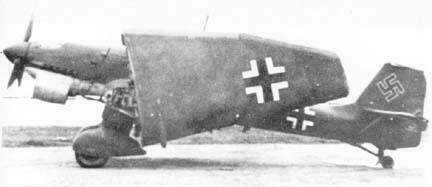
Junker Ju 87C.
[Source: Unknown]
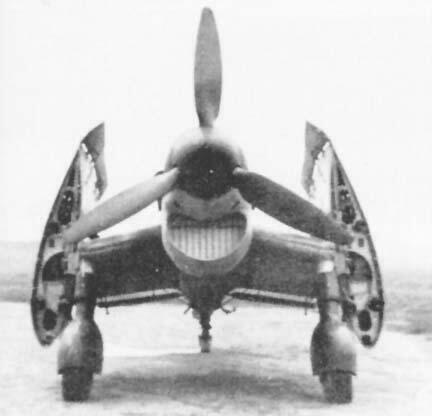
Junker Ju 87C.
[Source: Unknown]
Ju 87 V10: Registration D-IHFH (changed to Stammkennzeichen of TK+HD). W.Nr 4928. First flown 17 March 1938 Ju 87 V11: Stammkennzeichen of TV+OV. W.Nr 4929. First flown 12 May 1938
Ju 87D "Dora"
Despite the Stuka's vulnerability to enemy fighters having been exposed during the Battle of Britain, the Luftwaffe had no choice but to continue its development, as there was no replacement aircraft in sight. The result was the D-series. In June 1941, the RLM ordered five prototypes, the Ju 87 V21-25. A Daimler-Benz DB 603 powerplant was to be installed in the Ju 87 D-1, but it did not have the power of the Jumo 211 and performed "poorly" during tests and was dropped. The Ju 87 D-series featured two coolant radiators underneath the inboard sections of the wings, while the oil cooler was relocated to the position formerly occupied by the coolant radiator. The D-series also introduced an aerodynamically refined cockpit with better visibility and space. In addition, armor protection was increased and a new dual-barrel 7.92 mm MG 81Z machine gun with an extremely high rate of fire was installed in the rear defensive position. Engine power was increased again, the Ju mo 211J now delivering 1,420 PS (1,044 kW, 1,401 hp). Bomb carrying ability was nearly quadrupled from 500 kg (1,100 lb) in the B-version to 1,800 kg (3,970 lb) in the D-version (max. load for short ranges, overload condition), a typical bomb load ranged from 500-1,200 kg (1,100-2,650 lb).
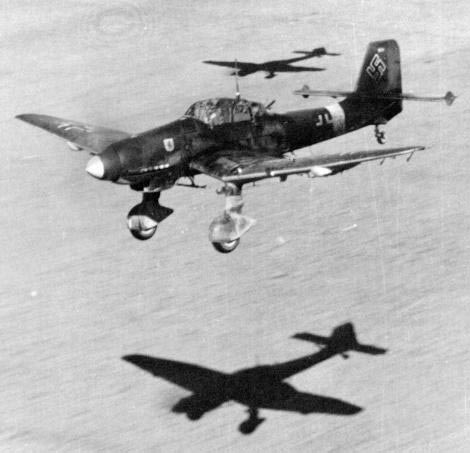
Junkers Ju 87D in low level flight.
[Source: Unknown]
Ju 87 V 21. Registration D-INRF. W.Nr 0870536. Airframe conversion from B-1 to D-1. First flown on 1 March 1941.
Ju 87 V 22 Stammkennzeichen of SF+TY. W.Nr 0870540. Also airframe conversion from B-1 to D-1. First flown on 1 March 1941.
Ju 87 V 23 Stammkennzeichen of PB+UB. W.Nr 0870542. Also airframe conversion from B-1 to D-1. First flown on 1 March 1941.
Ju 87 V 24 Stammkennzeichen of BK+EE. W.Nr 0870544. Also airframe conversion from B-1 to D-1/D-4. First flown on 1 March 1941.
Ju 87 V 25 Stammkennzeichen of BK+EF. W.Nr 0870530. Also airframe conversion from B-1 to D-4 trop. First flown on 1 March 1941.
Ju 87 V 30, the only known prototype of the Ju 87 D-5. W.Nr 2296. First flown on 20 June 1943.
Ju 87 V 26-28, Ju 87 V 31, and V 42-47 were experiments of unknown variants.
Ju 87G "Gustav"
With the G variant, the aging airframe of the Ju 87 found new life as an anti-tank aircraft. This was the final operational version of the Stuka, and was deployed on the Eastern Front. The reverse in German military fortunes after 1943 and the appearance of huge numbers of well-armoured Soviet tanks caused Junkers to adapt the existing design to combat this new threat. The Hs 129B had proved a potent ground attack weapon, but its large fuel tanks made it vulnerable to enemy fire, prompting the RLM to say "that in the shortest possible time a replacement of the Hs 129 type must take place." With Soviet tanks the priority targets, the development of a further variant as a successor to the Ju 87D began in November 1942. On 3 November, Erhard Milch raised the question of replacing the Ju 87, or redesigning it altogether. It was decided to keep the design as it was, but to upgrade the powerplant to a Jumo 211J, and add two 30 mm (1.18 in) cannon. The variant was also designed to carry a 1,000 kg (2,200 lb) free-fall bomb load. Furthermore, the armoured protection of the Ilyushin Il-2 Sturmovik was copied - a feature pioneered by the 1916-17 origin Junkers J.I of World War I Imperial Germany's Luftstreitkrofte - to protect the crew from ground fire now that the Ju 87 would be required to conduct low level attacks.
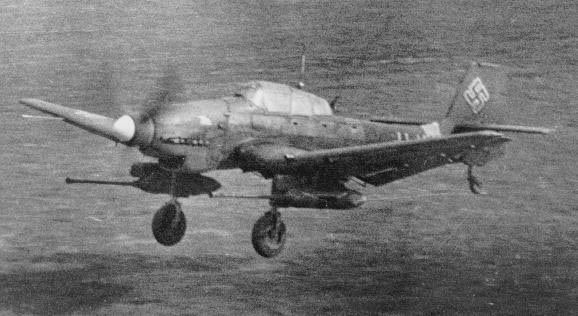
Junkers Ju 87G.
[Source: Unknown]
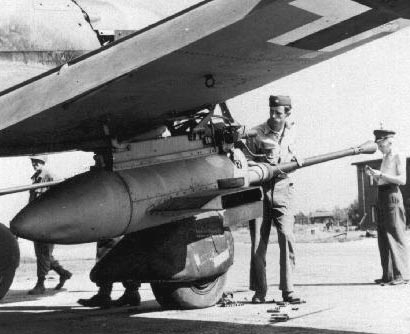
37mm Flak 18 mounted on a Junkers Ju 87G.
[Source: Unknown]
Night-harassment variants
The Soviet Air Force practice of harassing German ground forces using antiquated Polikarpov Po-2 and R-5 biplanes at night to drop flares and fragmentation bombs, inspired the Luftwaffe to form its own Störkampfstaffeln (harassment squadrons). On 23 July 1942, Junkers offered the Ju 87 B-2, R-2 and R-4s with Flammenvernichter ("flame eliminators"). On 10 November 1943, the RLM GL/C-E2 Division finally authorised the design in directive No. 1117. This new equipment made the Ju 87 more difficult to detect from the ground in darkness. Pilots were also asked to complete the new "Blind Flying Certificate 3", which was especially introduced for this new type of operation. Pilots were trained at night, over unfamiliar terrain, and forced to rely on their instruments for direction. The Ju 87's standard Revi C12D gunsight was replaced with the new Nachtrevi ("Nightrevi") C12N. On some Ju 87s, the Revi 16D was exchanged for the Nachtrevi 16D. To help the pilot see his instrument panel, a violet light was installed. On 15 November 1942, the Auxiliary Staffel were created. By mid-1943, Luftflotte 1 was given four Staffeln while Luftflotte 4 and Luftwaffe Kommando Ost (Luftwaffe Command East) were given six and two respectively. In the first half of 1943, 12 Nachtschlachtgruppen had been formed, flying a multitude of different types of aircraft, including the Ju 87, which proved itself ideally suited to the low-level slow flying needed.
Sources:
Gunston, Bill - The Encyclodepia of the Worlds Combat aircraft, 1976, Chartwell Books, Inc., New York
Brown, Eric, Captain - Wings of the Luftwaffe , 1979, Airlife Publishing Ltd., Shrewsbury
, 1979, Airlife Publishing Ltd., Shrewsbury
Gunston, Bill & Wood, Tony - Hitler's Luftwaffe , 1977, Salamander
Books Ltd., London
, 1977, Salamander
Books Ltd., London
Donald, David - The Complete Encyclopedia Of World Aircraft, 1997, Brown Packaging Books Ltd., London
Wikipedia - Junkers Ju 87
Gunston, Bill - The Encyclodepia of the Worlds Combat aircraft, 1976, Chartwell Books, Inc., New York
Brown, Eric, Captain - Wings of the Luftwaffe
Gunston, Bill & Wood, Tony - Hitler's Luftwaffe
Donald, David - The Complete Encyclopedia Of World Aircraft, 1997, Brown Packaging Books Ltd., London
Wikipedia - Junkers Ju 87






